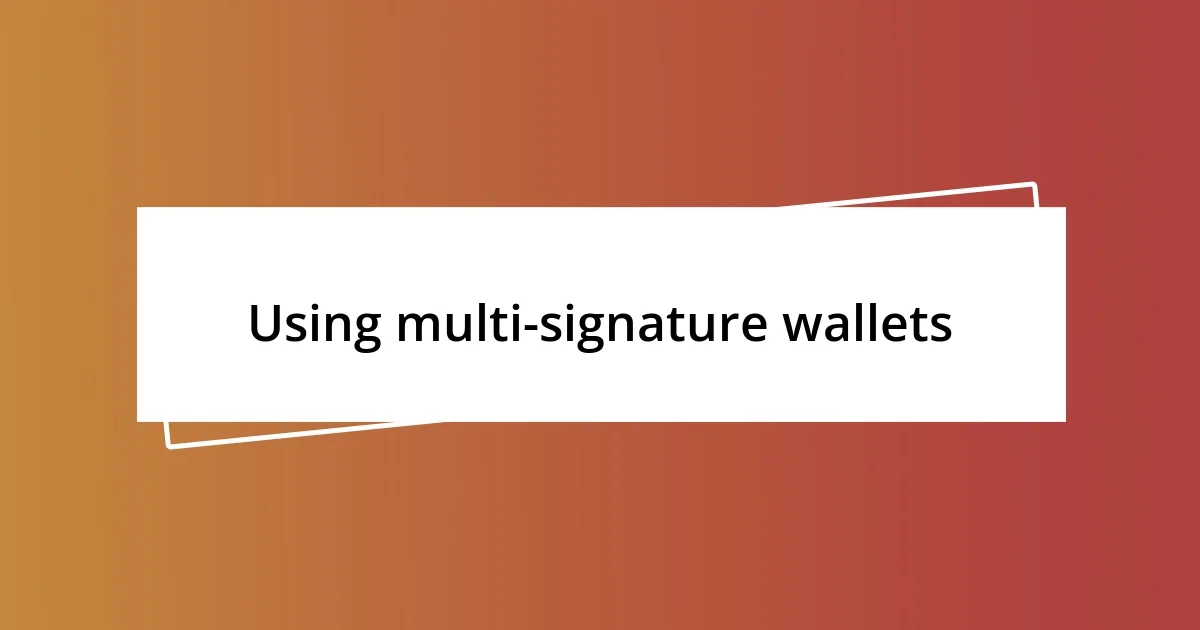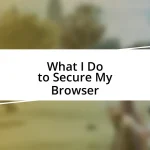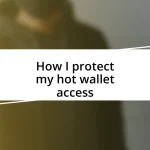Key takeaways:
- Understanding the risks associated with hot wallets, particularly their vulnerability to phishing attacks, weak passwords, and lack of two-factor authentication.
- Implementing best practices such as enabling two-factor authentication, regularly updating wallet software, and choosing reputable wallet providers to enhance security.
- The importance of ongoing education and community engagement to stay informed about security threats and improve private key management strategies.

Understanding hot wallet risks
When I first started using hot wallets, I was excited about the ease of access they provided. However, I quickly learned that the same features that make them user-friendly also make them vulnerable. Have you ever thought about how quickly your assets could vanish if a hacker found a way in? It’s a sobering thought, isn’t it?
One of the significant risks of hot wallets lies in their constant internet connection. This makes them particularly appealing targets for cybercriminals. I recall a time when my friend faced a devastating loss because he underestimated phishing attacks. Can you imagine waking up to find your assets drained overnight? That fear is all too real for many in our community.
Another aspect to consider is that hot wallets are often backed by less robust security measures compared to cold wallets. I remember experimenting with different platforms and was shocked to discover the lack of two-factor authentication on some. It made me wonder: how much are we willing to risk for convenience? As I learned more, I became more vigilant, realizing that enhancing my security practices was vital in safeguarding my investments.

Identifying common vulnerabilities
Just like any digital platform, hot wallets have their fair share of vulnerabilities that can put your assets at risk. I remember attending a crypto seminar where a security expert discussed the importance of understanding these weaknesses. It hit home when she showed us examples of attacks that exploited well-known flaws. I never thought about how something as simple as using a weak password could be a gateway for hackers.
Here are some common vulnerabilities associated with hot wallets:
- Phishing Attacks: Scammers often create fake websites or emails that look official, tricking users into providing their login details.
- Weak Passwords: Many users fail to employ strong, unique passwords, making it easier for unauthorized access.
- Lack of Two-Factor Authentication (2FA): Without this extra layer of security, one compromise could lead to total asset loss.
- Insider Threats: Sometimes, employees of a wallet service can exploit their access for unauthorized transactions.
- Software Vulnerabilities: Coding errors or outdated software can leave a wallet open to exploits.
Considering my own experiences, I became acutely aware of the need to regularly update my wallet software after hearing about someone who lost everything due to a simple oversight. Keeping up with these vulnerabilities is not just an academic exercise; it’s a crucial practice in protecting what matters most in this rapidly evolving space.

Best practices for secure wallets
To ensure your hot wallet remains secure, adopting best practices is crucial. For instance, I’ve found that enabling two-factor authentication (2FA) provides an extra layer of security that mitigates the risk of unauthorized access. It’s always a reassuring feeling to know that even if my password were compromised, it wouldn’t be the end of the world. Have you ever taken that extra step? The peace of mind it brings is undeniably worth it.
Regularly updating your wallet software is another habit I’ve integrated into my routine. By staying current with the latest security patches, I’m significantly reducing my exposure to known vulnerabilities. It’s kind of like maintaining your car; neglecting routine checks can lead to bigger problems down the road. I personally feel the weight lift when I take that proactive measure instead of waiting for something bad to happen.
Choosing a reputable wallet provider is essential too. I learned this the hard way when I briefly used an unpopular wallet and soon faced several security issues. Just like you wouldn’t buy a car from a sketchy dealer, you should select wallet services with a solid reputation. The last thing you want is to entrust your hard-earned assets to a service with a history of breaches.
| Best Practices | Description |
|---|---|
| Enable 2FA | Adds an extra layer of security beyond just passwords. |
| Regular Software Updates | Keeps you protected against known vulnerabilities. |
| Use Reputable Wallets | Choose established providers with strong security records. |

Regular monitoring and updates
Staying on top of my hot wallet’s security has taught me that regular monitoring is just as critical as implementing security measures. I make it a point to check my wallet’s transaction history frequently. It’s surprising how a quick glance can reveal unauthorized activity before it escalates. Have you ever caught something unexpected in your accounts? That sinking feeling of realizing something’s off is mitigated by vigilance.
Software updates might seem like a chore, but I see them as opportunities to reinforce my defenses. I remember a time when I overlooked an update, and shortly after, I learned of a breach in the wallet’s system that could’ve impacted me. It was like hearing someone say, “You missed a perfect chance to fortify your castle!” Now, I treat these updates as essential maintenance—integral to protecting my digital assets rather than an afterthought.
Also, I engage actively in cryptocurrency forums and news sites to stay informed about emerging threats and vulnerabilities. This helps me adapt my monitoring practices accordingly. For instance, after reading about a new phishing technique, I became even more vigilant about verifying any links before clicking. How often do you find yourself learning something that changes how you approach security? This ongoing education is vital; it allows me to stay one step ahead and feel empowered in navigating this dynamic landscape.

Using multi-signature wallets
Using multi-signature wallets has been a game changer for me in minimizing risks associated with hot wallets. When I first set one up, it felt like having my own digital fortress. The idea that multiple private keys are needed to authorize a transaction gives me peace of mind, almost like having to present multiple forms of ID at a bank. Have you ever felt the comfort of heightened security? I certainly do when I know that even if one key were compromised, my assets remain safe.
I remember the first time I faced a potential breach. Luckily, I had a multi-signature setup in place, which required a consensus from several keys to process any transactions. That day, I was so grateful I’d taken the extra step to implement this security measure. It felt empowering, like I was in control, not merely hoping for the best. This experience solidified my belief in the importance of having a robust security setup that ensures accountability and reduces risk.
It can seem a bit daunting at first, especially if you’re not super tech-savvy, but I promise it’s worth it. There are user-friendly platforms that simplify the process with clear steps and guides. I often wonder, what if I hadn’t taken the plunge? Would I still be as anxious about my hot wallet? Embracing this technology not only added layers of security but also boosted my confidence in managing my digital assets.

Importance of private key management
Managing private keys is an essential responsibility that can’t be overstated. I vividly recall the moment I learned just how important this was when I misplaced a key after a late-night session of organizing my digital assets. The panic that set in was palpable; it was like losing a part of my identity. That initial dread led me to develop a strict system for key storage and management, ensuring that each key was both secure and easily retrievable.
One strategy I adopted was using a reliable password manager. I remember feeling a wave of relief when I realized I could store my private keys securely, alongside my other sensitive information. It was reassuring to know that even if my computer were compromised, my keys remained safe within a protected vault. I can’t help but ask, have you ever found a solution that transformed your approach to security? For me, this was definitely a turning point in how I approached private key management.
Over time, I learned that keeping backups of my private keys in offline locations was crucial. I physically wrote them down and tucked them away in a safe spot, treating them like precious artifacts. The thought of losing access to my cryptocurrency felt overwhelming, and I wanted to ensure I had multiple fail-safes in place. Don’t you agree that having peace of mind about your investments can be transformative? With these strategies, I feel empowered and secure, knowing that my private keys are not just random strings of text but lifelines to my financial future.

Resources for ongoing education
Staying educated about wallet security is crucial, and I’ve often found myself returning to reputable online resources. For example, I stumbled upon a fantastic course on Udemy that covers everything from basic wallet setup to advanced security measures. It was an eye-opener for me; have you ever taken a course that completely changed your perspective? The interactive format allowed me to ask questions and engage with instructors, making the learning process feel dynamic and tailored to my needs.
Another resource that I frequently turn to is community forums, particularly Reddit and specialized cryptocurrency groups. It’s fascinating how sharing experiences can lead to collective wisdom. I remember posting a question about securing my hot wallet and was overwhelmed by the diverse range of suggestions and real-life stories shared by others. It made me realize that learning from peers can often be just as valuable as formal education. What have you found most helpful in learning from the community?
Books also play a vital role in my ongoing education. One that resonated with me deeply was “The Basics of Bitcoins and Blockchains” by Antony Lewis. I can still recall the excitement I felt as I navigated the chapters, gaining insights that directly impacted my approach to wallet security. Have you ever read something that felt like it was written just for you? That book helped me understand not only the technical side but also the underlying philosophy of cryptocurrency security, reinforcing my commitment to continuous learning in this fast-paced digital landscape.














